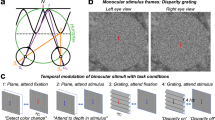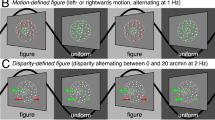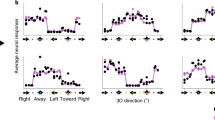Abstract
IN man the two eyes receive slightly differing views of the world. The visual system utilises this disparity for stereoscopic depth perception. This involves a difficult correspondence problem for establishing binocular fusion: for each surface feature extracted from one eye's image, the brain has to decide which is the equivalent feature in the other eye's image. Ambiguities often exist, particularly for densely-textured visual surfaces, but one aspect of binocular visual processing which helps reduce the scale of the problem is that for any given vergence angle, the visual system considers only those potential left/right fusions with disparities under a certain limiting size (defined by Panum's fusional areas1,2). This disparity limit, however, requires that when disparities greater than Panum's area are presented, a suitable vergence change must be initiated to bring corresponding features within the allowable range for fusion. A question currently of considerable theoretical interest concerns the nature of the stimulus characteristics used to initiate these essential vergence movements. The interest stems mainly from Marr and Poggio's model of human stereo vision3,4 in which false correspondences are avoided by seeking left/right fusions within spatial frequency tuned disparity channels whose disparity range is closely tied to their spatial frequency sensitivity5. By setting the disparity range of any given channel to about ± w (where w = the width of the centre of the receptive fields of the channel in question) Marr and Poggio have demonstrated that false matches are improbable and any that do emerge are easily eliminated using quite simple rules. A further feature of the model is that the outputs of low spatial frequency tuned channels (that is units capable of dealing with large disparities because of their relatively large receptive fields) can initiate vergence movements bringing into correspondence higher spatial frequency channels mediating smaller disparities. The theory predicts that in the case of a two-planar densely-textured stereogram (for example Fig. 1a–c] in which the disparity range exceeds the size appropriate for the lowest spatial frequency channels activated by the stereogram's texture, vergence movements should exhibit only a random-search structure. We report here an experimental test of this prediction which shows that vergence movements are not always random in the stimulus circumstances just specified. Rather, vergence can be guided by texture contours (Fig. 1b) depicted by differences of texture orientation between regions of relatively high spatial frequency content for the disparity range incorporated in the stereogram. Moreover, we find that such texture contours can facilitate stereopsis in a way consistent with the idea that they do so by initiating appropriate eye movements.
This is a preview of subscription content, access via your institution
Access options
Subscribe to this journal
Receive 51 print issues and online access
$199.00 per year
only $3.90 per issue
Buy this article
- Purchase on Springer Link
- Instant access to full article PDF
Prices may be subject to local taxes which are calculated during checkout
Similar content being viewed by others
References
Ogle, K. N. Archs Ophthal. 48, 50 (1952).
Fender, D. & Julesz, B. J. opt. Soc.. Am. 57, 819 (1967).
Marr, D. & Poggio, T. Proc. R. Soc. B204, 301 (1979).
Grimson, W. E. L. & Marr, D. Proc. Image Understanding Workshop (Inf. Proc. Tech. Office of DARPA, 1979).
Felton, T. B., Richards, W. & Smith, R. A. Jr J. Physiol., Lond. 225, 349 (1972).
Frisby, J. P., Mayhew, J. E. W. & Kidd, A. L. (in preparation).
Saye, A. & Frisby, J. P. Perception 4, 159 (1975).
Julesz, B. & Oswald, H. P. Perception 7, 315 (1979).
Ramachandran, V. S., Madhusudhan Rao, V. & Vidyasagar, T. R. Nature 202, 412 (1973).
Mayhew, J. E. W. & Frisby, J. P. Nature 264, 53 (1976).
Frisby, J. P. & Mayhew, J. E. W. Perception 7, (1978).
Kaufman, L. Sight and Mind (Oxford University Press, London, 1974).
Author information
Authors and Affiliations
Rights and permissions
About this article
Cite this article
KIDD, A., FRISBY, J. & MAYHEW, J. Texture contours can facilitate stereopsis by initiating vergence eye movements. Nature 280, 829–832 (1979). https://doi.org/10.1038/280829a0
Received:
Accepted:
Issue Date:
DOI: https://doi.org/10.1038/280829a0
Comments
By submitting a comment you agree to abide by our Terms and Community Guidelines. If you find something abusive or that does not comply with our terms or guidelines please flag it as inappropriate.



